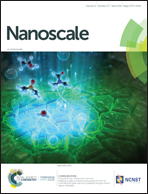The shielding effects of a C60 cage on the magnetic moments of transition metal atoms inside the corner holes of Si(111)-(7 × 7)†
Abstract
The strong interaction between transition metal (TM) atoms and semiconductor surface atoms may diminish the magnetic moments of the TM atoms and prevent them from being used as single atom spin-based devices. A carbon cage that can encapsulate TM atoms and isolate them from interacting with surface atoms is considered to protect the magnetic moments of the TM atoms. We have studied the magnetic moments of Fe, Co, and Ni atoms adsorbed inside the corner hole of Si(111)-(7 × 7) by using first-principles calculations based on the density functional theory. The results show that when Co and Ni atoms are directly adsorbed inside the corner hole, the magnetic moments are 1.353μB and 0, respectively. However when a C60 cage is used to encapsulate the atoms, the magnetic moments increase to 1.849μB and 0.884μB, respectively. The results show a clear protecting effect of a carbon cage. For Fe with and without C60, the magnetic moments are 2.909μB and 2.825μB, respectively. The presence of a C60 cage can also maintain their magnetic moments. Further analysis shows that the TM atoms possess magnetic moments when the conduction electrons are localized around them. All the results can be well understood in the framework of the Anderson impurity model. Our results demonstrate that a carbon cage may effectively protect the magnetic moments of TM atoms. This provides a new strategy for developing single atom spin-based devices on semiconductors.



 Please wait while we load your content...
Please wait while we load your content...